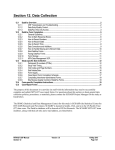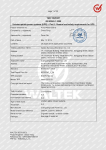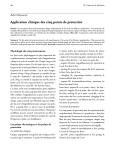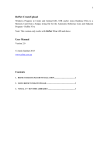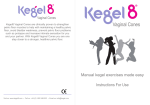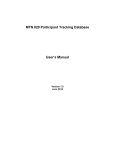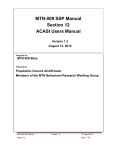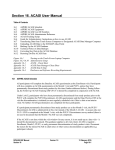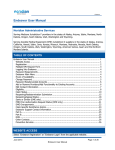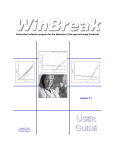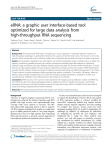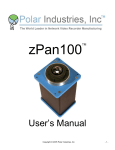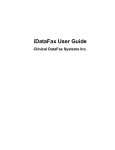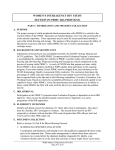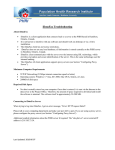Download Section 11. Data Collection
Transcript
Section 11. Data Collection 11.1 DataFax Overview....................................................................................................................... 11-2 11.1.1 CRF Transmission and Troubleshooting ................................................................................ 11-2 11.1.2 Data Entry/Quality Control.................................................................................................... 11-3 11.1.3 iDataFax View-only Access .................................................................................................. 11-3 11.2 DataFax Form Completion ........................................................................................................... 11-5 11.2.1 General Guidelines.............................................................................................................. 11-5 11.2.2 How to Mark Response Boxes.............................................................................................. 11-6 11.2.3 How to Record Numbers ...................................................................................................... 11-6 11.2.4 How to Record Dates .......................................................................................................... 11-7 11.2.5 How to Record Time ............................................................................................................ 11-8 11.2.6 Data Corrections and Additions ............................................................................................ 11-9 11.2.7 How to Handle Missing and Unknown Data ......................................................................... 11-10 11.2.8 Non-DataFax Forms .......................................................................................................... 11-10 11.2.9 Faxing DataFax Forms ...................................................................................................... 11-11 11.2.10 Form Storage................................................................................................................ 11-11 11.2.11 MTN Data Management SOP ......................................................................................... 11-11 11.3 Study-specific Data Collection .................................................................................................... 11-11 11.3.1 Participant ID numbers (PTIDs) .......................................................................................... 11-11 11.3.2 Study Visit Timing ............................................................................................................. 11-12 11.3.3 Visit Codes and Page Numbers ................................................................................................ 11-14 11.3.4 Staff Initials/Date ............................................................................................................... 11-16 11.3.5 Form Supply ..................................................................................................................... 11-16 11.3.6 Case Report Form Completion Schedule ........................................................................... 11-16 11.3.7 Completing Interviewer-administered Forms................................................................ 11-18 11.3.8 Site Review (Quality Control) of DataFax Forms ............................................................ 11-18 11.4 Form-specific Completion Instructions ...................................................................................... 11-18 11.5 Case Report Forms ................................................................................................................... 11-20 _____________________________________________________________________________________ The purpose of this document is to provide site staff with the information they need to successfully complete and submit MTN-028 case report forms. For questions about this section or about general data collection policies, procedures, or materials, please contact the SCHARP Project Manager for the study as listed below. The SDMC (Statistical and Data Management Center) for this study is SCHARP (the Statistical Center for HIV/AIDS Research and Prevention). SCHARP is located in Seattle, USA, and is in the US Pacific Time (PT) time zone. The DataFax database will be housed at DF/Net Research. The SCHARP MTN-028 team members, along with their job role and e-mail address, are listed below. MTN-028 SSP Manual Section 11 Version 1.1 18 August 2015 11–1 MTN-028 Statistical and Data Management Center (SDMC) Staff Job Role Name Email Address Protocol Statistician Jingyang Zhang [email protected] Statistical Research Associate Jason Pan [email protected] Project Manager Melissa Peda [email protected] Operations Programmer Drew Edwards [email protected] Database Manager Dena Seabrook [email protected] Lab Programmer Katie Snapinn [email protected] Clinical Affairs Safety Associate Ning Jiang [email protected] 11.1 DataFax Overview DataFax is the data management system used by DF/Net Research to receive and manage data collected at study sites. The site faxes an electronic image of each case report form (CRF) to DataFax, and the original hard copy CRF is retained by the site. 11.1.1 CRF Transmission and Troubleshooting Case report forms can be transmitted to DF/Net Research in one of two ways: faxed using a fax machine connected to a land phone line (fax to phone number 1-866-807-8681); or faxed using a fax machine connected to the internet (fax to e-mail < [email protected] >). DF/Net Research’s DataFax support group is available to consult with the site to determine the best method for data transmission. The DataFax support group can be contacted via e-mail at <[email protected]>. This group should also be contacted anytime the site has technical questions or problems with their fax equipment. MTN-028 SSP Manual Section 11 Version 1.1 18 August 2015 11–2 11.1.2 Data Entry/Quality Control Once a CRF image is received by DF/Net, the following occurs: • DataFax identifies the study to which each CRF belongs using the barcode at the top of the form. It reads and enters the data into the study database and stores each CRF on a computer disk. • Next, each CRF is reviewed by at least two staff members at DF/Net. Problems such as missing or potentially incorrect data are identified and marked with Quality Control notes (QCs). • QCs are compiled into QC reports that are sent via e-mail to the study site on a regular basis. Sites are asked to correct or clarify any problems identified on the QC reports and refax the corrected CRFs to DF/Net. • When the refaxed pages are received, DF/Net Research staff review the corrected pages and resolve the QCs. If a change is made to a CRF but the updated page is not refaxed to DF/Net Research DataFax, the change will not be entered and the study database will continue to contain incomplete or incorrect data. Additionally, if the change was prompted by a QC, the QC will continue to appear on subsequent QC reports until the modified CRF is received at DF/Net Research. Therefore, it is very important that the site refax updated CRF pages to DF/Net Research DataFax any time a change is made to a CRF, regardless of whether or not the change was made in response to a QC report. 11.1.3 iDataFax View-only Access Each site will be able to access and view its own MTN-028 CRF data via iDataFax view-only access. With view-only access, sites can view their faxed CRF images and data, view their QCs and clinical queries, identify missing CRF pages or visits, and export their data. This will allow the user to review and resolve QCs even before they can be included on a QC report. Being able to see the CRF image and what is in the database can also help the user to better understand what needs to be modified or reported on the paper CRF to resolve the QC or query. NOTE: View-only access means that the user can view what’s in iDataFax, but cannot enter or modify data, or respond to QCs or clinical queries. In addition, sites will not be able to view or access other sites’ data. To obtain view-only access to its study data, each site must first download the iDataFax software by logging into the DF/Net Research Kronos web site: https://kronos.dfnetresearch.com. Each Site Coordinator will be set up with a Kronos and iDataFax user account prior to study start. As each new user account is set up, the user will receive a “Welcome to the Kronos Web Site new user registration” e-mail, from the e-mail address [email protected], with instructions on logging into the Kronos system for the first time and setting up a new user password. To obtain new user accounts for additional site staff members, please contact the SCHARP Project Manager. Once a site staff member logs into the Kronos site, s/he may access and download the iDataFax software by clicking on the “DATAFAX 2014” project folder (see screenshot below). MTN-028 SSP Manual Section 11 Version 1.1 18 August 2015 11–3 The folder contains links for downloading the iDataFax software, as well as an iDataFax User Manual with detailed instructions on downloading, logging into, and using iDataFax (see screenshot below). MTN-028 SSP Manual Section 11 Version 1.1 18 August 2015 11–4 For technical assistance with logging into and navigating the Kronos site, please contact the SCHARP Project Manager and the team at [email protected]. For questions or technical assistance with iDataFax, please contact the SCHARP Project Manager and the team at [email protected]. 11.2 DataFax Form Completion 11.2.1 General Guidelines Based on the use of fax technology and Good Clinical Practices (GCPs), the following guidelines should be used for completing DataFax CRFs: • Use a black or dark blue medium ballpoint pen. Do not use any other type of writing tool. Use only one color per form. That is, do not begin completing a form using a blue pen and then switch to a black pen during the same form completion session. • Press firmly when recording data or writing comments. • Print all data and comments legibly by hand. Entries that cannot be read will result in QC notes. • Do not type data onto CRFs. Do not use cursive/script handwriting, as it can be difficult to read. • Write numbers as large as possible while staying within the boundaries of the boxes. • Record data on the front of CRFs only. DataFax cannot read the back of CRFs. • Do not record data or make marks in the 0.5-inch/1.5-cm margins at the top, bottom, or sides of the CRF. • If the lines provided for written responses are not long enough, continue in another blank area of the form (within the page margins). • Mark only one answer except when given the instruction “Mark all that apply.” • A response is required for every item unless instructed otherwise by a skip pattern. • Never obscure, mark over, or punch holes through the barcode at the top of each CRF. DataFax requires the barcode to identify the CRF. • Never use correction fluid (“white-out”) or correction tape on CRFs. • Remove any paper clips, staples, or other attachments before faxing CRFs. • The site staff person who initially completes the form must record his/her initials and the date in the space provided in the bottom right-hand corner of each CRF page. • Fax forms as soon as possible after they have been completed and reviewed. Ideally, completed forms will be faxed to DF/Net within 1–2 days of completing the visit, though up to 5 days is allowed. MTN-028 SSP Manual Section 11 Version 1.1 18 August 2015 11–5 11.2.2 How to Mark Response Boxes Many items on DataFax CRFs have a box or series of boxes for recording a response. Mark the box clearly with an X. Do not fill in the box with shading or mark it with a slash or other character. Mark only one response box for each item unless the “Mark all that apply” instruction is present. 11.2.3 How to Record Numbers Some questions on DataFax CRFs include boxes for recording a numeric response. DataFax can only read the numbers in these boxes if they are recorded clearly. The following instructions should be followed when recording numeric responses: • Right justify all numbers and fill in any blank leading boxes with zeroes. If boxes are left blank, a QC note will be applied asking for the boxes to be filled in. The following example shows how a value of 7 is recorded when three response boxes are provided: • Write the number(s) as large as possible while staying within the boundaries of the box; try not to stray outside the boundaries of the box. In the following example, the 4 could be misinterpreted as a 7 or a 1 because DataFax can only read what is inside the box: • Write the number(s) simply, with few loops. The following example shows the format in which numbers will be most easily read by DataFax. Also included are some commonly used formats that may be difficult for DataFax to identify. MTN-028 SSP Manual Section 11 Version 1.1 18 August 2015 11–6 11.2.4 How to Record Dates Dates are recorded using the “dd MMM yy” format, where “dd” represents the two-digit day, “MMM” represents the three-letter abbreviation of the month (in capital letters), and “yy” represents the last two digits of the year. The month field must be filled in with the three-letter abbreviation in English for the date to be read in DataFax. Abbreviations are shown in the table below. Month Abbreviation Month Abbreviation January JAN July JUL February FEB August AUG March MAR September SEP April APR October OCT May MAY November NOV June JUN December DEC For example, June 6, 2015 is recorded as: MTN-028 SSP Manual Section 11 Version 1.1 18 August 2015 11–7 Sometimes, only a month and a year are required (e.g., diagnosis date for a pre-existing condition), in which case the response boxes will look like this: A diagnosis date of October, 2015 would be recorded as follows: 11.2.5 How to Record Time Time is recorded on DataFax CRFs using the 24-hour clock (00:00-23:59), in which hours are designated from 0–23. For example, in the 24-hour clock 2:25 p.m. translates to 14:25 (2 p.m. = 14), which would be recorded as follows: Midnight is recorded as 00:00, not 24:00. The following chart shows equivalencies between the 12- and 24-hour clocks: MTN-028 SSP Manual Section 11 12-hour clock (a.m.) 24-hour clock 12-hour clock (p.m.) 24-hour clock Midnight 00:00 Noon 12:00 1:00 a.m. 01:00 1:00 p.m. 13:00 2:00 a.m. 02:00 2:00 p.m. 14:00 3:00 a.m. 03:00 3:00 p.m. 15:00 4:00 a.m. 04:00 4:00 p.m. 16:00 5:00 a.m. 05:00 5:00 p.m. 17:00 Version 1.1 18 August 2015 11–8 6:00 a.m. 06:00 6:00 p.m. 18:00 7:00 a.m. 07:00 7:00 p.m. 19:00 8:00 a.m. 08:00 8:00 p.m. 20:00 9:00 a.m. 09:00 9:00 p.m. 21:00 10:00 a.m. 10:00 10:00 p.m. 22:00 11:00 a.m. 11:00 11:00 p.m. 23:00 11.2.6 Data Corrections and Additions Sometimes, data on a DataFax CRF may need to be changed, clarified, or amended. There are many reasons why data may need to be changed, such as in response to a QC report or as a result of site review of the CRF before faxing. It is important to make these changes to the original CRF—never copy data onto a new form. After making the change, the CRF must be re-faxed to DF/Net Research DataFax. Note: If a correction or addition is made to one page of a multiple-page CRF, only refax the page that was changed. Initial and date all changes or additions. Note: Never write over an entry once it is recorded. Use the standards outlined in the following paragraphs when changing, clarifying, or amending data. Whenever an entry on a DataFax CRF is changed, do the following: • draw a single horizontal line through the incorrect entry (do not obscure the entry or make it un-readable with multiple cross-outs), • place the correct or clarified answer near the box, and • initial and date the correction as shown below: • If an X is marked in the wrong response box, correct it by doing the following: draw a single horizontal line through the incorrectly marked box, • mark the correct box, and MTN-028 SSP Manual Section 11 Version 1.1 18 August 2015 11–9 • initial and date the correction as shown below: If the correct answer has previously been crossed out, do the following: • circle the correct item, • write an explanation in the white space near the item, and • initial and date all corrections as shown below: The standards above must always be followed whenever a CRF is changed, clarified, or amended, even if the change is made before the CRF is faxed to DF/Net Research for the first time. 11.2.7 How to Handle Missing and Unknown Data If the answer to an item is not known, is not available, or if the participant refuses to answer, draw a single horizontal line through the blank boxes and initial and date the item. It is helpful to write “don’t know,” “refuses to answer,” “UNK” (unknown), “N/A” (not applicable), or “REF” (refused) near the blank boxes. For example, when recording a date, if the exact day is not known, draw a single horizontal line through the “dd” boxes and write “don’t know” next to the response boxes, as shown below: A skip pattern is the only valid reason to leave a response blank. Initials and date are required for any data item that is refused, missing, unknown, or not applicable, regardless of whether it is marked as such during the initial form completion, or as an update to the form. 11.2.8 Non-DataFax Forms Non-DataFax forms are case report forms that are used for data documentation purposes, but are not faxed to DF/Net Research. These forms are created to ensure consistent and accurate data documentation across study sites for data that is not needed in the study database. Non-DataFax form is easily identifiable because there is no DataFax barcode along the top of the CRF. In place of the barcode, the following text appears: “NOT A DATAFAX FORM. DO NOT FAX TO DATAFAX.” Non-DataFax forms are completed using the general guidelines presented above, and completed forms are stored just as DataFax forms in participant files/binders. MTN-028 SSP Manual Section 11 Version 1.1 18 August 2015 11–10 11.2.9 Faxing DataFax Forms Each CRF with a bar code at the top is a DataFax form, and is faxed to DataFax once completed and reviewed as described in the site’s MTN Data Management SOP. Sites are encouraged to develop a system that identifies each time a form page is faxed so that re-faxing of unchanged forms can be avoided. A date stamp used on the back of the form page may be used for this purpose as long as the date stamp does not obscure data recorded on the front of the form page. 11.2.10 Form Storage Specifications for form storage are described in the site’s MTN Data Management SOP. It is recommended that for each participant, study CRFs be stored in a hard-cover notebook, with a tabbed section for CRFs completed at each study visit. It is suggested that log forms (such as the Concomitant Medications Log, Adverse Experience Log, Clinical Product Hold/Discontinuation Log, Social Impact Log, and Protocol Deviations Log) be kept in their own tabbed sections within the participant study notebook. This makes page numbering and updating of these forms easier than if these forms are stored by visit within the participant’s study notebook. 11.2.11 MTN Data Management SOP As a condition for study activation, each study site must have an SOP for MTN Data Management. This SOP should be reviewed and followed in combination with the information contained in the study protocol, this SSP Manual, and the site’s Clinical Quality Management Plan (CQMP). The MTN Data Management SOP contains information on and outlines site staff responsibilities for several data topics, including: Participant ID (PTID) assignment Participant study file organization Participant confidentiality Site data quality control (QC) processes Timing of DataFax form data transmission Data QC processes Data storage 11.3 Study-specific Data Collection 11.3.1 Participant ID numbers (PTIDs) DataFax uses a unique participant identification number (PTID) to identify each study participant in the database. Prior to study start, SCHARP provides each site with a list of PTIDs to be used for the study in the form of a study-specific MTN PTID Name-Linkage Log. The site assigns one PTID to each participant screened for the study. The PTIDs are assigned in sequential order as participants present for the screening visit. The site should ensure that each PTID is assigned only once. Once a participant has received a PTID that same PTID is maintained for that participant for the duration of her study participation. MTN-028 SSP Manual Section 11 Version 1.1 18 August 2015 11–11 PTID boxes are located near the upper left corner of each CRF page. The PTIDs used for this study are nine digits and formatted as “XXX-YYYYY-Z.” The PTID consists of three parts: the DataFax site number (XXX), the participant number (YYYYY), and a numerical check digit (Z). The check digit (Z) is a number generated by SCHARP with the participant number, and helps ensure that the correct PTID is recorded. Below is an example of the PTID structure used in MTN-028. 11.3.2 Study Visit Timing Screening and Enrollment The initial screening visit is defined as the day the participant provided written informed consent to be screened and enrolled for the study. The initial Screening Visit (that is, the date the informed consent form was signed for screening and enrollment) may take place up to 45 days prior to the Enrollment Visit. The date the participant is enrolled/randomized is Study Day 0 for the participant. Screening Attempts (Re-screens) Refer to Section 4: Study Procedures of this manual for guidance related to repeat screening attempts (re-screens) by a participant. If a participant re-screens, all screening procedures and CRFs must be repeated with the exception of PTID assignment and Eligibility Criteria CRF completion (see paragraph below). Once a PTID is assigned to a participant that PTID is used for the re-screen procedures and forms completed for that participant (do not assign a new PTID). If a participant re-screens and enrolls in the study, only case report forms from the successful screening and enrollment visits are faxed to DF/Net. Note that in this case, the Eligibility Criteria CRF completed during the failed screening attempt should be updated and re-faxed with CRFs from the participant’s successful screening and enrollment visits (do not complete a new Eligibility Criteria CRF for the successful screening attempt). Follow-Up Visits For each required follow-up study visit, the visit type, visit code, target visit day, and visit window are listed in Table 11-1. Target days and windows are listed in days, with the day of enrollment/randomization as study day 0. Target Days and Visit Windows Whenever possible, visits should be completed on the target day or within the target window. SCHARP will provide sites with a spreadsheet tool that may be used to generate individual participant follow-up visit calendars based upon the participant’s enrollment date and menstrual MTN-028 SSP Manual Section 11 Version 1.1 18 August 2015 11–12 cycle. The spreadsheet requires that the participant’s Enrollment date be entered. Once the enrollment date is entered, the target days and visit windows for follow-up visits through Day 28 will appear. The remaining study visit target days and visit windows will depend on the actual date of each participant’s Day 28 visit. There are no visit windows around Days 1, 2, 29 and 30 as these are daily visits. The calendar can be printed, added to the participant’s study notebook and updated as needed. Split Visits For MTN-028, Enrollment Visits may not be split. Whenever possible, all required follow-up visit evaluations should be completed on the same day. In those cases where this is not possible, the participant may come back and complete the remaining evaluations on another day, as long as that day is within the allowable visit window. For example, a participant comes in on Day 35 to complete the Final Clinic Visit and completes all of the required evaluations, but has to leave prior to completing a blood draw for safety labs. She comes back the next day on Day 36 and completes the remaining required procedures. This is allowed, and is referred to as a “split” visit; as the participant completed all required visit evaluations on two separate days, both days being in the visit window. Note that for split visits, only one Follow-up Visit Summary CRF is completed, and all CRFs completed for the visit are assigned the same visit code. The “Visit Date” on the Follow-up Visit Summary CRF is the date of the first part of the split visit. See Section 11.3.3 for more information on assigning visit codes to split visits. Table 11-1: Visit Timing Requirements MTN-028 study visit schedule Visit code 1.0 2.0 Visit type Screening Visit Enrollment target day </- 45 days 0 Visit Window n/a +45 days after Scr. 3.0 4.0 5.0 6.0 7.0 8.0 9.0 10.0 11.0 12.0 13.0 Day 1 Day 2 Day 3 Day 7 Day 14 Day 21 Day 28 Day 29 Day 30 Day 31 Day 35/Final Clinic Visit 1 2 3 7 14 21 28 1 day after visit 9.0 2 days after visit 9.0 3 days after visit 9.0 7 days after visit 9.0 Same as target day Same as target day Days 3-5 Days 6-8 Days 13-15 Days 20-22 Days 27-29 Same as target day Same as target day +2 after target day +/- 1 day around target day MTN-028 SSP Manual Section 11 Version 1.1 18 August 2015 11–13 Missed Visits In those cases where a participant is not able to complete any part of a required follow-up visit within the visit window, the visit is considered “missed”. For example, an enrolled participant does not report to the clinic for her Day 2 Visit. Per table 11-1, this visit has been missed. The missed visit is documented in the study database by completion of a Missed Visit CRF that is faxed to DF/Net. Interim Visits An interim visit occurs when there is a contact with the participant, but required follow-up visit procedures are not done because the required follow-up visit has already been completed. An interim visit may also occur via a phone contact if the participant reports a new AE that requires reporting on an AE-1 CRF, or the participant is instructed by study staff to hold or permanently discontinue study product use. All interim contacts with the participant should be documented in a chart note. Additionally, if the interim contact results in at least one newly-completed DataFax CRF, the interim contact is assigned an interim visit code (visit code ending in something other than “.0”). All phone contacts that meet interim visit criteria per paragraph above are also assigned interim visit codes. See section 11.3.3 for information on how to assign visit codes to interim visits. Note that for MTN-028, there is no Interim Visit CRF. Instead, a Follow-up Visit Summary CRF is completed for interim visits/contacts as needed. Item 6 of the Follow-up Visit Summary CRF will document whether the visit is a required (regular) visit or an interim visit. The following is an example of an interim visits: A participant completes her Day 7 visit as scheduled. On Day 10 post-enrollment, the participant reports to the clinic unexpectedly to report a new AE. Why is this an interim visit? The required visit procedures for the Day 7 visit have been completed already, and a new AE is reported. An interim visit code is assigned as new CRFs will be completed (Follow-up Visit Summary, AE Log, possibly others). Early Termination Visits An early termination visit can occur at any point during the study after participant randomization. If an early termination visit is conducted, the Day 35/scheduled Final Clinic Visit procedures should be completed, providing participant willingness. The visit code of the early termination visit will depend on where the participant is at in her visit schedule at the time of early termination. 11.3.3 Visit Codes and Page Numbers The MTN-028 non-log CRFs will include boxes in the upper right corner for a visit code. DataFax uses the visit code to identify the visit at which a CRF is completed. When visit code boxes are MTN-028 SSP Manual Section 11 Version 1.1 18 August 2015 11–14 present, site staff is responsible for recording the appropriate visit code. The table below lists the visit codes assigned to each required follow-up visit. Table 11-2: Visit Code Assignments for Required Follow-up Visits Visit # Visit Visit Code 1 2 3 4 5 6 7 8 9 10 11 12 13 Screening Visit Enrollment Visit Day 1 Day 2 Day 3 Day 7 Day 14 Day 21 Day 28 Day 29 Day 30 Day 31 Day 35/Final Clinic Visit 01.0 02.0 03.0 04.0 05.0 06.0 07.0 08.0 09.0 10.0 11.0 12.0 13.0 Visit Codes for Split Visits See Section 11.3.2 for a definition of split visits. When split visits occur, the CRFs completed for the visit are all assigned the same visit code (ending in “.0”), even though the dates will differ between some of the CRFs. Visit Codes for Interim Visits For interim visits, interim visit codes are assigned using the following guidelines: • In the two boxes to the left of the decimal point, record the two-digit visit code for the most recently required visit, even if the visit was missed and/or if the participant is within the next visit’s window. • For the box to the right of the decimal point: - #.1 = the first interim visit after the most recently-required follow-up visit, - #.2 = the second interim visit after the most recently-required follow-up visit, - #.3 = the third interim visit after the most recently-required follow-up visit, and so on. Example #1: A participant completes her Day 31 visit (visit code = 12.0) on the target day. She returns to the site one day later to report a new symptom. This interim Visit is assigned an interim visit code of 12.1: MTN-028 SSP Manual Section 11 Version 1.1 18 August 2015 11–15 Visit code for this Interim Visit Page numbers Other CRFs, such as log forms (e.g., Adverse Experience Log or Concomitant Medications Log), may include boxes in the upper right corner for page numbers, as shown below: Assign page numbers in sequential order, starting with 01 (or 001, for Adverse Experience Log CRFs). Assign numbers in sequential order (for example, the second Concomitant Medications Log page would be assigned page number 02, the third page would be assigned 03, and so on. 11.3.4 Staff Initials/Date Most forms include a line in the lower-right corner for a staff member’s initials and the date on which the form was completed. When more than one staff member records data on a CRF, the site should designate the staff member who has primary responsibility for the form. This individual completes the staff initials/date field. The individual not identified in the staff initials/date field writes his/her initials and date next to each data element for which he/she is responsible. 11.3.5 Form Supply Sites are responsible for creating their own supplies of MTN-028 case report forms. Sites should print CRFs from pdf files provided by SCHARP (available on the MTN-028 Atlas web page). CRF pdf files will include visit packets pdfs (containing all of the CRFs required to be completed for the visit) as well as a pdf file containing all of the CRFs created for the study. Site are encourage to test and make sure the CRFs they have produced can be read into DataFax by using a test fax pdf provided by DF/Net Research. A test fax should be done each time new printing, photocopying, or faxing equipment is installed or modified, and also when paper used for CRFs changes. 11.3.6 Case Report Form Completion Schedule The provided forms for this study include DataFax forms (forms that are completed and faxed to DF/Net Research DataFax) and non-DataFax forms (forms that are completed but not faxed to DF/Net Research DataFax). Some DF/Net Research -provided forms are required to be completed at each visit, while other forms are required only at one visit or only when specifically indicated. The following table (Table 11-3) lists the DataFax and non-DataFax forms that are required to be completed at each study visit. MTN-028 SSP Manual Section 11 Version 1.1 18 August 2015 11–16 Table 11.3: Schedule of Forms – CRFs Required to be Completed at Each Visit Visit 1 (Screening Visit): Visit Code 1.0 DataFax forms Non-DataFax forms Concomitant Medications Log Pelvic Exam Diagrams Demographics Eligibility Criteria Pelvic Exam Pre-existing Conditions Physical Exam Safety Laboratory Results Visit 2 (Enrollment Visit): Visit Code 2.0 DataFax forms Non-DataFax forms Pelvic Exam Diagrams Enrollment Physical Exam Pelvic Exam Pharmacokinetics Specimens – Enrollment Safety Laboratory Results Specimen Storage Visit Day 1, 2, 3, 7, 21: Visit Codes 3.0 – 8.0 DataFax Forms Follow-up Visit Summary Physical Exam Pelvic Exam Pelvic Exam Ring Assessment Pharmacokinetics Specimens – Days 1, 2, 3, 7, 14, 21, 29, 30, 31, 35 Ring Adherence Non-DataFax forms Pelvic Exam Diagrams At Visit 5.0/Day 3 only: Specimen Storage Visit Day 28: Visit Code 9.0 DataFax forms Follow-up Visit Summary Pelvic Exam Pelvic Exam Ring Assessment Physical Exam Pharmacokinetics Specimens– Day 28 Ring Adherence Ring Collection and Insertion Specimen Storage Safety Laboratory Results Non-DataFax forms Pelvic Exam Diagrams Visit Days 29, 30, & 31: Visit Code 10.0-12.0 DataFax forms Non-DataFax forms MTN-028 SSP Manual Section 11 Version 1.1 18 August 2015 11–17 Follow-up Visit Summary Pelvic Exam Physical Exam Pharmacokinetics Specimens – Days 1, 2, 3, 7, 14, 21, 29, 30, 31, 35 Pelvic Exam Diagrams Visit Day 35: Visit Code 13.0 DataFax forms Follow-up Visit Summary HIV Results Pelvic Exam Physical Exam Pharmacokinetics Specimens - Days 1, 2, 3, 7, 14, 21, 29, 30, 31, 35 Safety Laboratory Results Specimen Storage Termination 11.3.7 Non-DataFax forms Pelvic Exam Diagrams Completing Interviewer-administered Forms In order to standardize interviewer-administered data collection from site to site and to maximize quality, it is critical that participant interviews be conducted with a non-biased, non-judgmental approach. Study staff should help a participant feel comfortable sharing personal information and opinions while asking the study questions in a consistent manner from participant to participant. 11.3.8 Site Review (Quality Control) of DataFax Forms As described in the site’s MTN Data Management SOP (and referenced in the site’s Clinical Quality Management Plan, CQMP), each site must perform two Quality Control (QC) review steps prior to faxing DataFax forms to DF/Net Research. While DataFax CRFs are being reviewed, it is important that they are stored and tracked systematically. 11.4 Form-specific Completion Instructions Detailed form completion instructions for each form are provided on the back of each form page. Some items on forms are straightforward and do not require specific instructions. Therefore, you will not see all form items listed in the form-specific completion instructions, but rather, only those items needing detailed explanation. Below are additional instructions for some of the CRFs used in this study. These instructions do not appear on the back of the form page due to lack of space. Enrollment (ENR) CRF – Randomization date and time (Item 5) The date and time of a participant’s randomization should be completed using the FSTRF randomization confirmation email. The randomization time within this confirmation email is provided in Eastern Standard Time (EST). When completing item 5 on the Enrollment CRF, convert the time of randomization according to the site’s local standard time zone. . MTN-028 SSP Manual Section 11 Version 1.1 18 August 2015 11–18 Adverse Experience Log (AE) Do not wait until the AE resolves before faxing the form page to DF/Net. Always make changes, corrections, and updates to the originally-completed form page (do not complete a new form). Once an AE Log form page has been started and faxed to DF/Net Research, the data from that page should never be transcribed onto another AE Log form page. Note that AE Log page numbers do not need to be assigned in any special order with regard to AE onset date or date reported to site. For example, if it is discovered that for a participant, page 001 and 003 were assigned, but not 002, simply assign page # 002 to the next AE Log form you complete. It does not matter if the AE’s onset date or date reported to site on page 002 is later than these dates reported on AE Log page 003 (a QC will not be generated). For item 1, note that planned procedures or surgeries are not AEs. For example, a tonsillectomy is not an AE; rather, it is a treatment that will be collected in item 8. Any adverse experiences associated with the planned procedure or surgery, are AEs. Provide a rationale or alternative etiology in the Comments section for all reported AE regardless of relationship to study product. Ensure that any relevant information provided in the Comments section is also provided in item 1 (the text description of the AE). This will help avoid MedDRA coding queries during the study. For example, if a participant reports vaginal discharge and the AE is deemed not related to study product due to an infectious etiology, provide relevant descriptors (either the diagnosis or that the vaginal discharge is due to infection) in item 1. Pharmacokinetics Specimens - Enrollment (PKS-1) In item 1, record the start and stop dates of the participant’s last last menstrual period. If the participant is unable to recall the complete date of last menstrual period, obtain participant's best estimate. At a minimum, the month and year are required. Only record dates of menstrual period bleeding (including expected monthly bleeding on oral contraceptive pills). If a participant has not had a menses in the past 30 days, mark ‘none’. If the participant is currently on her menses, mark ‘ongoing’. In these cases, this item does not need to be updated with a stop date once known at a later visit. Pharmacokinetics Specimens – Day 28 (PKS-1) and Pharmacokinetics Specimens – Days 1, 2, 3, 7, 14, 21, 29, 30, 31, 35 (PKD-1) In item 1, record the start and stop dates of the last vaginal bleeding that the participant experienced. This includes menstrual period bleeding, withdrawal bleeding, and expected breakthrough bleeding experienced while the participant is on Depo, Mirena, or other continuous contraceptive method where a women does not experience a monthly menstrual period. If a participant has not had any vaginal bleeding in the past 30 days, mark ‘none’. If the participant is currently bleeding at the time of the study visit, mark ‘ongoing’. This item does not need to be updated with a stop date once known at a later visit. If silver nitrate/monsels solution is used to stop bleeding during the collection of cervical biopsies, this should be noted in the comments section of the PKS to better inform PK analyses of the vaginal swabs collected on Day 28. Document this medication on the concomitant medications log CRF. MTN-028 SSP Manual Section 11 Version 1.1 18 August 2015 11–19 Concomitant Medications Log (CM-1) When recording injections (e.g., Hepatitis B vaccine, Depo-Provera), record each injection as its own separate entry. The “Date Started” and “Date Stopped” dates should be the same date. Mark the “once” box for “Frequency” and the appropriate box for “Route” (e.g., “IM”, or “Other” for subcutaneous injections). Recreational drugs should not be reported as concomitant medications for this protocol. Clinical Product Hold/Discontinuations log (PH-1) If “no – hold continuing at the Day 28 visit” is marked in Item 4, record the date that the Day 28 (visit 9.0) visit was completed. If the Day 28 visit is missed, record the target date of the Day 28 visit, per the participant’s visit schedule. If the reason for the hold later meets criteria for permanent discontinuation between the participant’s Day 28 visit and her date of termination, update the response in Item 4 to “no – permanently discontinued” and record the date the reason first met criteria for permanent discontinuation. If “no – permanently discontinued” is marked in Item 4, record the date that the reason in Item 2 met criteria for permanent discontinuation. This date could fall anytime between the participant’s enrollment visit up through her Termination date. Pelvic Exam Ring Assessment (PER) 11.5 When completing the PER CRF at the Day 28 visit, mark ‘yes’ in item 2 if the vaginal ring was present at the start of the exam, as you will remove and collect the vaginal ring at this visit. The hour and minute boxes in item 2a should be lined through, initialed, and dated to indicate that this item is not applicable. Item 3 should be marked “not reinserted”. For item 3a, record “Day 28 – end of product use” as the reason that the ring was not reinserted. Case Report Forms The MTN-028 CRFs are posted on the ATLAS webpage for downloading and printing. The current version of the MTN-028 case report forms (not for actual data collection purposes use) can be found on the MTN-028 SSP web page on the MTN website (www.mtnstopshiv.org). MTN-028 SSP Manual Section 11 Version 1.1 18 August 2015 11–20




















